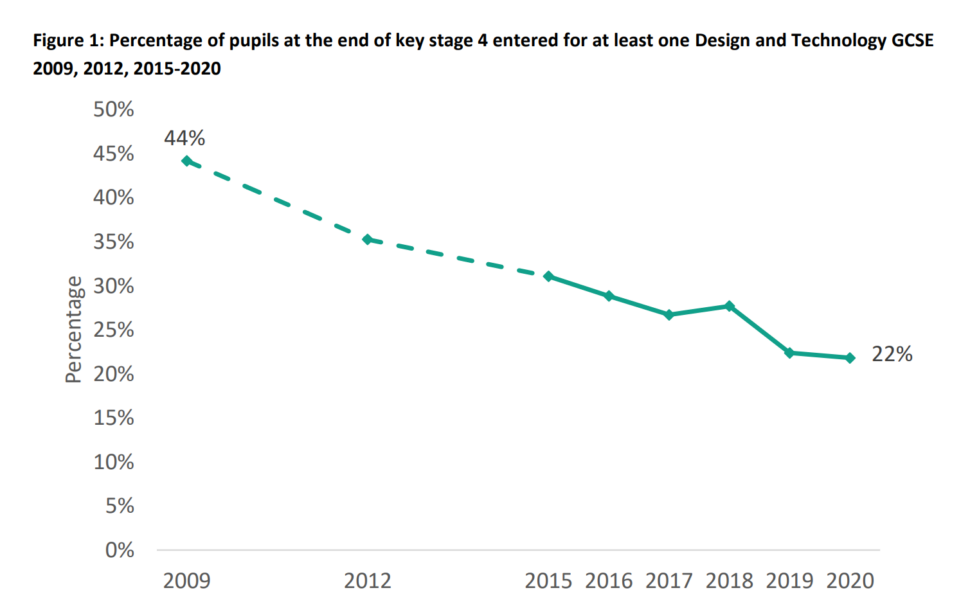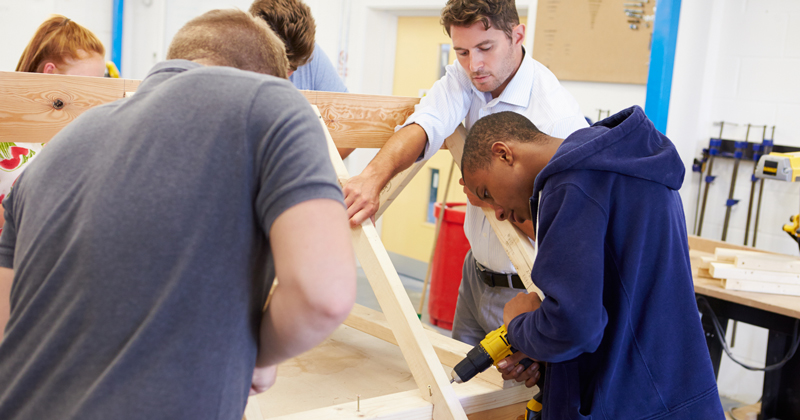The government is facing calls to better promote the study of design and technology after a report showed the number of pupils taking a GCSE in the subject has halved in just over a decade.
Research by the Education Policy Institute found just 136,150, or around 22 per cent of pupils, entered a design and technology GCSE in 2020, down from 280,670, or 44 per cent, in 2009.
Even fewer pupils go on to take the subject in sixth form. In 2020, just 10,430 pupils entered a design and technology A-level, down from 10,420 in 2009.
The report was funded by the Institute of Engineering and Technology, the Design and Technology Association, the James Dyson Foundation, Foster + Partners and the ERA Foundation.
The decline in design and technology uptake is often blamed on accountability measures such the English Baccalaureate, which focuses on academic subjects and don’t explicitly require creative or practical subjects to be taken.
EBacc a ‘potential factor’
In its report, the EPI named accountability reforms as a “potential factor” driving the subject’s decline, but also pointed to falling teacher numbers, curriculum and qualification reforms and “potential capital restraints” for schools.
These make for an “unclear picture as to why entries have declined so persistently”.
“However, what is clear is that without specific changes to encourage take up, the long-term declining trend is showing no sign of reversing,” the report said.
Geoff Barton, from the ASCL school leaders’ union, said it “did not help that the government decided to prioritise a set of traditional academic subjects in its English Baccalaureate….at the expense of other subjects”.
“While schools strive to provide their students with a full and rounded curriculum, they have to do this under the glare of intense accountability pressures, squeezed budgets, and a government which has made it clear that certain subjects are more important than others.”

The report looked at design and technology uptake in different parts of the country, by different groups of pupils and by types of school.
It found that boys were historically more likely to take design and technology GCSE, but entries by both genders had fallen since 2009.
The report also found that pupils in converter academies and local authority maintained schools were more likely to enter a design and technology GCSE than those in sponsored academies or free schools.
The subject’s popularity also varies hugely by postcode. In Herefordshire, four in ten pupils take it at GCSE, while in Middlesbrough the figure is 4 per cent. White British pupils are also more likely to take the subject than black African or Gypsy/Roma pupils.
Decline could harm vocational education push
The decline in design and technology comes as the government is attempting to place greater emphasis on vocational study.
The EPI said the government should consider the impact of the decline, “including whether it could harm plans to boost vocational education and tackle skill shortages”.
If the government wants to reverse the “considerable” decline in entries, “specific policies that encourage pupil take up will be required, particularly at GCSE level”, the report concluded.
Tony Ryan, from the Design and Technology Association, said the subject was “more relevant than it has arguably ever been”, but faces “many challenges”.
He said the report “points to the need for the skills agenda pre-sixteen to take precedence as we seek to prepare, inform, and inspire a workforce motivated and able to face the opportunities raised by the fourth industrial revolution”.
A DfE spokesperson said it wanted “every child and young person to benefit from a broad and balanced curriculum, which helps them to thrive academically and creatively”.
“Design and technology can teach young people vital practical skills, inspire their creativity, and help their wellbeing. It is compulsory in primary and up to year 9 in state-maintained schools, and is included in the headline measures for school accountability.”









The fact that more emphasis is now put on the theory side of Design &Technology, countabalances the draw to the subject from more practically minded pupils who would do better in a hands on environment rather than academia. Obviously DT can ve taken further into As and through to engineering, new technologies etc. But the first steps have been greatly hindered by the weighting of the marks taking the focus from Design and make to being able to sit written papers and produce pages of written information.
Also, keeping a breast with new technologies is still in my opinion, in its infancy and successful developments of this in schools by their creative curriculum planning should be recognised, praised and utilised.